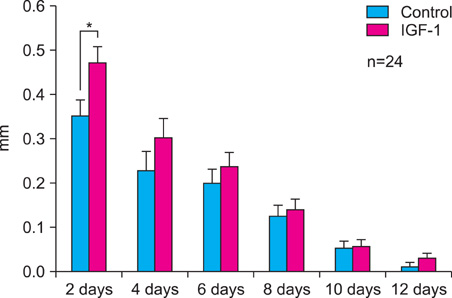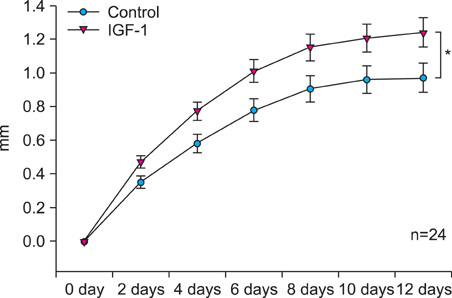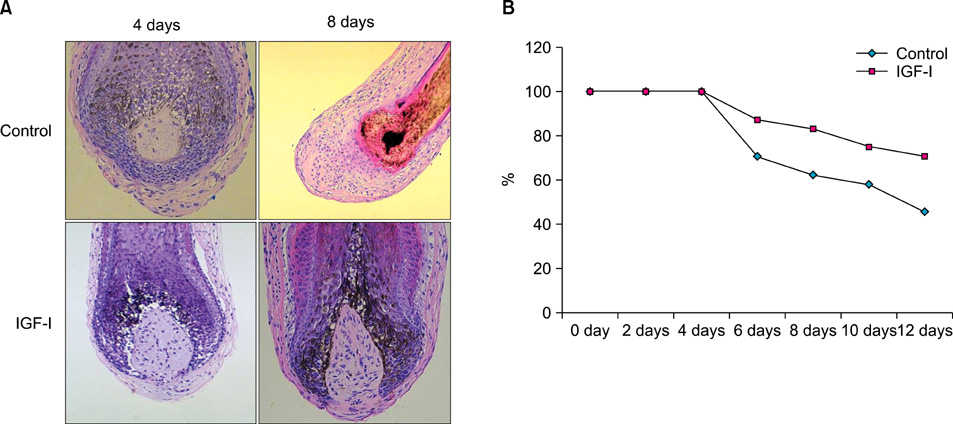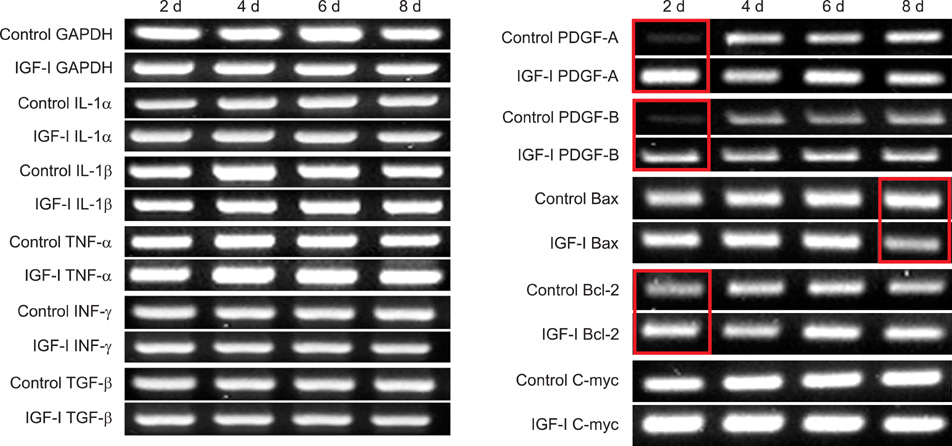Effect of IGF-I on Hair Growth Is Related to the Anti-Apoptotic Effect of IGF-I and Up-Regulation of PDGF-A and PDGF-B
- Affiliations
-
- 1Department of Dermatology and Institute of Hair and Cosmetic Medicine, Yonsei University Wonju College of Medicine, Wonju, Korea. leewonsoo@yonsei.ac.kr
- 2Dr. Hwang's Hair-Hair Clinic, Seoul, Korea.
- KMID: 2156852
- DOI: http://doi.org/10.5021/ad.2012.24.1.26
Abstract
- BACKGROUND
Insulin-like growth factor-I (IGF-I) shares a high degree of structural and functional homology with insulin and is a potent mitogen supporting cell growth and survival in many kinds of the tissues and cells. It also plays a role in some differentiation and anti-apoptotic functions. In previous reports, it has been shown that IGF-I stimulates hair follicle (HF) growth, maintains the anagen stage, and postpones the catagen stage.
OBJECTIVE
The exact mechanism of the effect of IGF-I on HF growth is not yet established. Therefore, we investigated the relationships between IGF-I and various other factors (i.e. apoptosis related molecules, pro-inflammatory cytokines, other growth factors, etc.) in the control of HF growth.
METHODS
The effect of IGF-I on human hair growth was measured using an organ culture model of human HFs and compared with a control group that did not receive IGF-I. We also measured mRNA expression of factors related to hair growth and apoptosis (which was determined by reverse transcription polymerase chain reaction (RT-PCR). RT-PCR was done on days 2, 4, 6, and 8 of organ culture.
RESULTS
In organ cultured human hair follicles, IGF-I had a positive effect on the rate of linear hair growth. IGF-I maintained the anagen phase. IGF-I increased the expression of platelet-derived growth factor (PDGF)-A, PDGF-B and the expression ratio of Bcl-2/Bax.
CONCLUSION
The effect of IGF-I on hair growth appears to be related to the upregulation of PDGF-A and PDGF-B and to the anti-apoptotic effect of IGF-I.
Keyword
MeSH Terms
-
Apoptosis
Cytokines
Hair
Hair Follicle
Humans
Insulin
Insulin-Like Growth Factor I
Intercellular Signaling Peptides and Proteins
Organ Culture Techniques
Platelet-Derived Growth Factor
Polymerase Chain Reaction
Reverse Transcription
RNA, Messenger
Up-Regulation
Cytokines
Insulin
Insulin-Like Growth Factor I
Intercellular Signaling Peptides and Proteins
Platelet-Derived Growth Factor
RNA, Messenger
Figure
Cited by 4 articles
-
Role of Arachidonic Acid in Promoting Hair Growth
Semchin Munkhbayar, Sunhyae Jang, A-Ri Cho, Soon-Jin Choi, Chang Yup Shin, Hee Chul Eun, Kyu Han Kim, Ohsang Kwon
Ann Dermatol. 2016;28(1):55-64. doi: 10.5021/ad.2016.28.1.55.Attenuation of Dickkopf 1-Induced Hair Growth Inhibition in Cultured Human Hair Follicles by Tianeptine
Hyun Sik Jeong, Mi Hee Kwack, Moon Kyu Kim, Jung Chul Kim, Young Kwan Sung
Ann Dermatol. 2017;29(1):102-105. doi: 10.5021/ad.2017.29.1.102.Synthesized Ceramide Induces Growth of Dermal Papilla Cells with Potential Contribution to Hair Growth
Jee Hye Oh, Kwan Ho Jeong, Jung Eun Kim, Hoon Kang
Ann Dermatol. 2019;31(2):164-174. doi: 10.5021/ad.2019.31.2.164.Expression Pattern and Role of Klotho in Human Hair Follicles
Xing-Hai Jin, Long-Quan Pi, Won-Soo Lee
Ann Dermatol. 2019;31(5):511-517. doi: 10.5021/ad.2019.31.5.511.
Reference
-
1. Jones JI, Clemmons DR. Insulin-like growth factors and their binding proteins: biological actions. Endocr Rev. 1995. 16:3–34.
Article2. Ben Amitai D, Lurie R, Laron Z. I-GF-1 signalling controls the hair growth cycle and the differentiation of hair shafts. J Invest Dermatol. 2006. 126:2135.
Article3. Bol DK, Kiguchi K, Gimenez-Conti I, Rupp T, DiGiovanni J. Overexpression of insulin-like growth factor-1 induces hyperplasia, dermal abnormalities, and spontaneous tumor formation in transgenic mice. Oncogene. 1997. 14:1725–1734.
Article4. Liu JP, Baker J, Perkins AS, Robertson EJ, Efstratiadis A. Mice carrying null mutations of the genes encoding insulin-like growth factor I (Igf-1) and type 1 IGF receptor (Igf1r). Cell. 1993. 75:59–72.
Article5. Itami S, Inui S. Role of androgen in mesenchymal epithelial interactions in human hair follicle. J Investig Dermatol Symp Proc. 2005. 10:209–211.
Article6. Tavakkol A, Elder JT, Griffiths CE, Cooper KD, Talwar H, Fisher GJ, et al. Expression of growth hormone receptor, insulin-like growth factor 1 (IGF-1) and IGF-1 receptor mRNA and proteins in human skin. J Invest Dermatol. 1992. 99:343–349.
Article7. Ullrich A, Schlessinger J. Signal transduction by receptors with tyrosine kinase activity. Cell. 1990. 61:203–212.
Article8. Lindner G, Botchkarev VA, Botchkareva NV, Ling G, van der Veen C, Paus R. Analysis of apoptosis during hair follicle regression (catagen). Am J Pathol. 1997. 151:1601–1617.9. Philpott MP, Sanders DA, Kealey T. Effects of insulin and insulin-like growth factors on cultured human hair follicles: IGF-I at physiologic concentrations is an important regulator of hair follicle growth in vitro. J Invest Dermatol. 1994. 102:857–861.
Article10. Ito T, Ito N, Saathoff M, Bettermann A, Takigawa M, Paus R. Interferon-gamma is a potent inducer of catagen-like changes in cultured human anagen hair follicles. Br J Dermatol. 2005. 152:623–631.
Article11. Rückert R, Lindner G, Bulfone-Paus S, Paus R. High-dose proinflammatory cytokines induce apoptosis of hair bulb keratinocytes in vivo. Br J Dermatol. 2000. 143:1036–1039.
Article12. Hoffmann R, Eicheler W, Wenzel E, Happle R. Interleukin-1beta-induced inhibition of hair growth in vitro is mediated by cyclic AMP. J Invest Dermatol. 1997. 108:40–42.
Article13. Kamp H, Geilen CC, Sommer C, Blume-Peytavi U. Regulation of PDGF and PDGF receptor in cultured dermal papilla cells and follicular keratinocytes of the human hair follicle. Exp Dermatol. 2003. 12:662–672.
Article14. Tomita Y, Akiyama M, Shimizu H. PDGF isoforms induce and maintain anagen phase of murine hair follicles. J Dermatol Sci. 2006. 43:105–115.
Article15. Philpott MP, Sanders D, Westgate GE, Kealey T. Human hair growth in vitro: a model for the study of hair follicle biology. J Dermatol Sci. 1994. 7:Suppl. S55–S72.
Article16. Tsuboi R, Sato C, Kurita Y, Ron D, Rubin JS, Ogawa H. Keratinocyte growth factor (FGF-7) stimulates migration and plasminogen activator activity of normal human keratinocytes. J Invest Dermatol. 1993. 101:49–53.
Article17. Paus R, Cotsarelis G. The biology of hair follicles. N Engl J Med. 1999. 341:491–497.
Article18. Soma T, Ogo M, Suzuki J, Takahashi T, Hibino T. Analysis of apoptotic cell death in human hair follicles in vivo and in vitro. J Invest Dermatol. 1998. 111:948–954.
Article19. Su HY, Hickford JG, The PH, Hill AM, Frampton CM, Bickerstaffe R. Increased vibrissa growth in transgenic mice expressing insulin-like growth factor 1. J Invest Dermatol. 1999. 112:245–248.
Article20. Tavakkol A, Elder JT, Griffiths CE, Cooper KD, Talwar H, Fisher GJ, et al. Expression of growth hormone receptor, insulin-like growth factor 1 (IGF-1) and IGF-1 receptor mRNA and proteins in human skin. J Invest Dermatol. 1992. 99:343–349.
Article21. Stenn KS, Lawrence L, Veis D, Korsmeyer S, Seiberg M. Expression of the bcl-2 protooncogene in the cycling adult mouse hair follicle. J Invest Dermatol. 1994. 103:107–111.
Article22. Seiberg M, Marthinuss J, Stenn KS. Changes in expression of apoptosis-associated genes in skin mark early catagen. J Invest Dermatol. 1995. 104:78–82.
Article23. Burgess W, Liu Q, Zhou J, Tang Q, Ozawa A, VanHoy R, et al. The immune-endocrine loop during aging: role of growth hormone and insulin-like growth factor-I. Neuroimmunomodulation. 1999. 6:56–68.
Article
- Full Text Links
- Actions
-
Cited
- CITED
-
- Close
- Share
- Similar articles
-
- Mitogenic effects of nicotine to human periodontal ligament(PDL) cells in vitro
- Effect of Growth Factors on Type I Collagen Synthesis in Cultured Rabbit's Deep Flexor Tendon Cell
- Age Related Local Growth Factors Affect Muscle Regeneration in Distraction Osteogenesis
- Ideal concentration of growth factors in rabbit's flexor tendon culture
- IGF-I Exerts an Anti-inflammatory Effect on Skeletal Muscle Cells through Down-regulation of TLR4 Signaling





